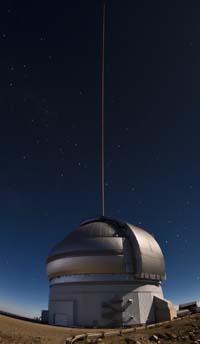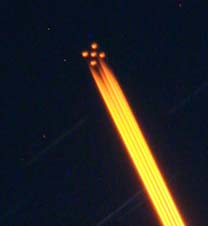Anyone who's been to a group observing session recently knows how valuable green lasers have become to our enjoyment of stargazing. Those pencil-thin beams of light allow us to point out objects in the sky and even to aim our telescopes effortlessly. (Of course, some idiots insist on pointing them at aircraft, a dangerous practice that's a huge disservice to those of us who use them responsibly.)
At the professional level, the stakes are higher and the toys bigger. Many major observatories already have — or are developing — systems that use powerful lasers to project pinpoints of light high in the atmosphere. These serve as artificial guide stars for adaptive-optics systems that correct for less-than-ideal "seeing" (atmospheric turbulence). When everything works, celestial targets can be recorded with astonishing clarity.

A beam of laser light streaks upward from the Gemini South telescope early on January 22, 2011. In this 20-second fish-eye view, a bright gibbous Moon illuminates the dome and foreground. Click here for a larger view.
Most observatories use a single laser-generated beacon, which limits how much of the telescopic field can be manipulated using adaptive optics. Typical targets are discrete objects like close-spaced double stars or compact clusters. But a new development at Gemini South observatory high in the Chilean Andes holds promise for extending adaptive optics' high resolution to much wider fields.
On January 22nd, researchers test-fired a laser that created a tight five-star "constellation" in the sky above Cerro Pachón. With an output of 50 watts — 1,000 times more powerful than a typical handheld unit — the laser is tuned to sodium atoms' strong yellow emission at 589 nm. After being split into five separate beams, the laser light illuminates sodium atoms naturally present in a layer within the mesosphere, about 60 miles (90 km) high. Those atoms then fluoresce at the same wavelength to create five artificial stars, each about 1 arcsecond across, at the corners and center of a 1-arcminute square.
Gemini South is the first facility to use this multiple-beam technique with a sodium laser. Project leader Celine d'Orgeville explains that Gemini's Multi-Conjugate Adaptive Optics (MCAO) system should allow the observatory's 26.6-foot (8.1-m) aperture to record ultrasharp views over fields up to 2 arcminutes across. Sometime next year astronomers hope to start using the MCAO system to study objects ranging from just-born stars to distant galaxies.

The MCAO system's 50-watt laser creates a tiny "constellation" of five artificial guide stars in a layer of sodium atoms about 60 miles (90 km) high. Overexposed in this 30-second exposure, the powerful beam of laser light can be seen dimly by eye from locations near the observatory.
Maxime Boccas / Benoit Neichel / Gemini Observatory
At least two other facilities are pursuing adaptive-optics systems that employ multiple guide stars. In 2007 the European Southern Observatory's Very Large Telescope tested a system that uses natural guide stars, but its use is limited because of the scarcity of suitable telescopic fields. That same year the MMT Observatory in Arizona tested a system that uses a powerful green laser to create multiple artificial stars using Rayleigh scattering in the lower atmosphere.
Click here to read more about Gemini's five-star system (and to see more great photos of last month's demonstration). d'Orgeville says another test is planned for February.
 1
1
Comments
Justin
February 2, 2011 at 7:32 am
I do belive it is a federal offense to aim a laser at an aircraft.
You must be logged in to post a comment.
You must be logged in to post a comment.